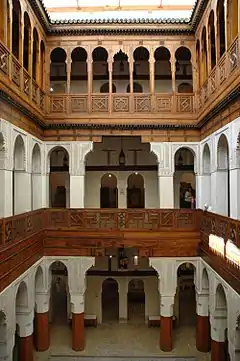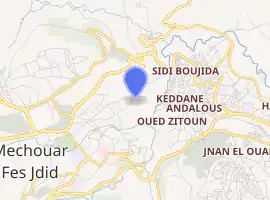Funduq al-Najjarin
Funduq al-Najjarin (Arabic: فندق النجارين, lit. 'Inn of the carpenters') (also spelled Fondouk (el-)Nejjarine) is a historic funduq (a caravanserai or traditional inn) in Fes el Bali, the old medina quarter in the city of Fez, Morocco.
| Funduq al-Najjarin | |
|---|---|
فندق النجارين | |
 Courtyard of the funduq. | |

| |
| General information | |
| Type | funduq (caravanserai) |
| Architectural style | Marinid, Moroccan, Islamic |
| Location | Fes, Morocco |
| Coordinates | 34°03′53″N 4°58′33″W |
| Completed | 1711 CE (1123 AH) |
| Renovated | 1990-1996 |
| Technical details | |
| Material | cedar wood, brick, stucco, tile |
| Floor count | 3 |
The funduq is situated in the heart of the medina, at Al-Najjarin Square (also: Nejjarine Square or Place Nejjarine), which is also notable for the Nejjarine Fountain, an attached saqayya or traditional public fountain.[1][2] The building was designed for use by the merchants, traders, and visitors to the city of Fez and provided a storage place. It is a prominent example of Moroccan riad architecture. Today it houses a private museum, Le Musée Nejjarine des Arts et Métiers du Bois (Nejjarine Museum of Wooden Arts & Crafts).[3]
History
.jpg.webp)
The name al-Najjarin (or the French transliteration Nejjarine; Arabic: النجارين) means "carpenters", a reference to the historic presence of a carpenters' souq (market) around the square in front of the funduq today.[2] The souq is believed to have existed since the Marinid era (1244-1465 CE).[4]
The funduq was commissioned by the amin (provost or magistrate) 'Adiyil in 1711, under the reign of the Alaouite Sultan Ismail Ibn Sharif.[5][2][6][1] Its attached saqayya (fountain) was commissioned in the 19th century by the Sultan Abd al-Rahman (ruled 1822–1859).[2] Despite these developments from different dates, the various structures and the public square form an integrated whole in the local community. The building was originally used as a trading center, caravanserai (inn), and merchant warehouse associated closely with the Makhzen (the government or royal authorities).[5][7] It likely continued to serve this function up until the beginning of the 20th century.[4] Another funduq founded in the same year (1711), the Funduq Sagha (Arabic: فندق الصاغة, lit. 'inn of the goldsmiths') in northern Fes el-Bali, also exhibits a very similar architecture and decorative style.[4]
The funduq was classified as a national historic monument in 1916 and was used as a police station by the French colonial authority in the 1940s.[5] The building was restored between 1990 and 1996, and on May 23, 1998 it was reopened as a private museum for wood arts and crafts known as Le Musée Nejjarine des Arts et Métiers du Bois.[2][1][5]
Architecture
The funduq
The building is built on an almost symmetrical rectangular plan. The interior is accessed through a monumental entrance leading to the lobby and the central courtyard or sahn. This gate, 5 meters tall and 3 meters wide, is framed by a facade of rich floral and geometrical decorations and inscriptions in stucco and tilework, and overlooked by an impressive carved cedar-wood canopy. The courtyard inside is rectangular and surrounded by a three-story gallery on all sides giving access to many different rooms. Rooms for the guests were located on the upper floors.[2]
.jpg.webp) The portal and facade of the funduq.
The portal and facade of the funduq..jpg.webp) Details of the decoration of the portal.
Details of the decoration of the portal..jpg.webp) Gallery around the second floor.
Gallery around the second floor..jpg.webp) Gallery around the third (top) floor.
Gallery around the third (top) floor. Pieces of woodwork on display in the museum today.
Pieces of woodwork on display in the museum today.
The fountain
A saqayya is normally constructed as a part of the charity work and attached to the buildings such as mosque as an accessory (similar to a sabil in other parts of the Islamic world), but it constitutes an integral part of the structure for this funduq. The saqayya is placed in front of the building, facing the square. The water was used for drinking, especially for the guests of the hotel. It is enclosed by two columns and richly decorated by zellij, stucco, and its own carved wooden canopy.[2]
.jpg.webp) View of the fountain.
View of the fountain..jpg.webp) Details of the fountain's decoration.
Details of the fountain's decoration.
References
| Wikimedia Commons has media related to Fondouk el-Nejjarine. |
- Funduq al-Najjariyyin. Archnet. Retrieved January 23, 2018.
- Nejjarin Funduq. Museum with no Frontiers. Retrieved January 23, 2018.
- "Nejjarine Museum of Wooden Arts & Crafts | Fez, Morocco Attractions". Lonely Planet. Retrieved 2020-03-18.
- Touri, Abdelaziz; Benaboud, Mhammad; Boujibar El-Khatib, Naïma; Lakhdar, Kamal; Mezzine, Mohamed (2010). Le Maroc andalou : à la découverte d'un art de vivre (2 ed.). Ministère des Affaires Culturelles du Royaume du Maroc & Museum With No Frontiers. ISBN 978-3902782311.
- "Introduction". Nejjarine Museum of Wood Arts and Crafts web site. Retrieved March 2020. Check date values in:
|access-date=(help) - Métalsi, Mohamed (2003). Fès: La ville essentielle. Paris: ACR Édition Internationale. p. 250. ISBN 978-2867701528.
- "FONDOUK NEJJARINE – Regional Council of Tourism FEZ". Retrieved 2020-03-18.
Bibliography
- Hillenbrand, Robert. Islamic Architecture. NY: Columbia UP, 1994. 240-251.
- Pickens et al. Maroc: Les Cites Imperiales. Paris: ACR Edition. 1995.
